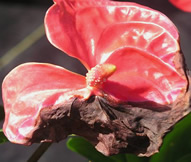Diseases
The two major diseases are bacterial blight and anthracnose.
Anthracnose

Bacterial blight disease
|
Bacterial blight disease is caused by Xanthomonas campestris pv. dieffenbachiae. In the humid tropics, high rainfall coupled with year-round high temperatures increases the severity and spread of bacterial blight disease making it a very important impediment to the cultivation of anthurium. Blackening of the stem and decay of leaf axils are the symptoms of bacterial blight.
|

Control
Spraying mancozeb 0.3% or carbendazim 0.05% can control the disease. Root rot caused by Pythium and Phytophthora can be controlled by the application of potassium phosphonate 0.3%.
- Cutivar resistance
The most effective control measure for bacterial blight disease is the use of resistant cultivars. The use of such cultivars will reduce the cost and risk associated with anthurium cultivation.
Pests
The major pests are scales and bugs, which are controlled by spraying malathion @ 2 ml per litre of water.
Snails also cause damage to young roots. Slugs and snails are of quarantine significance on exported plant material. Control must be 100% for quarantine security. Sanitation is vital to slug control. Slugs escape hot, dry conditions by hiding between the soil surface and any material on the soil during the daytime. Removing boards, pots, and any debris from growing areas will reduce slug cover for slug and snail breeding areas. Pruning anthurium plants will allow sunlight to reach the soil. Weather conditions affect slug and snail populations. Hot dry weather or excessive flooding can reduce the populations; while cool, damp weather encourages population growth. Baits are the preferred method of control. Baits consist of a base that is attractive to slugs plus a poison. Use of metaldehyde can prevent the attack of snails.
